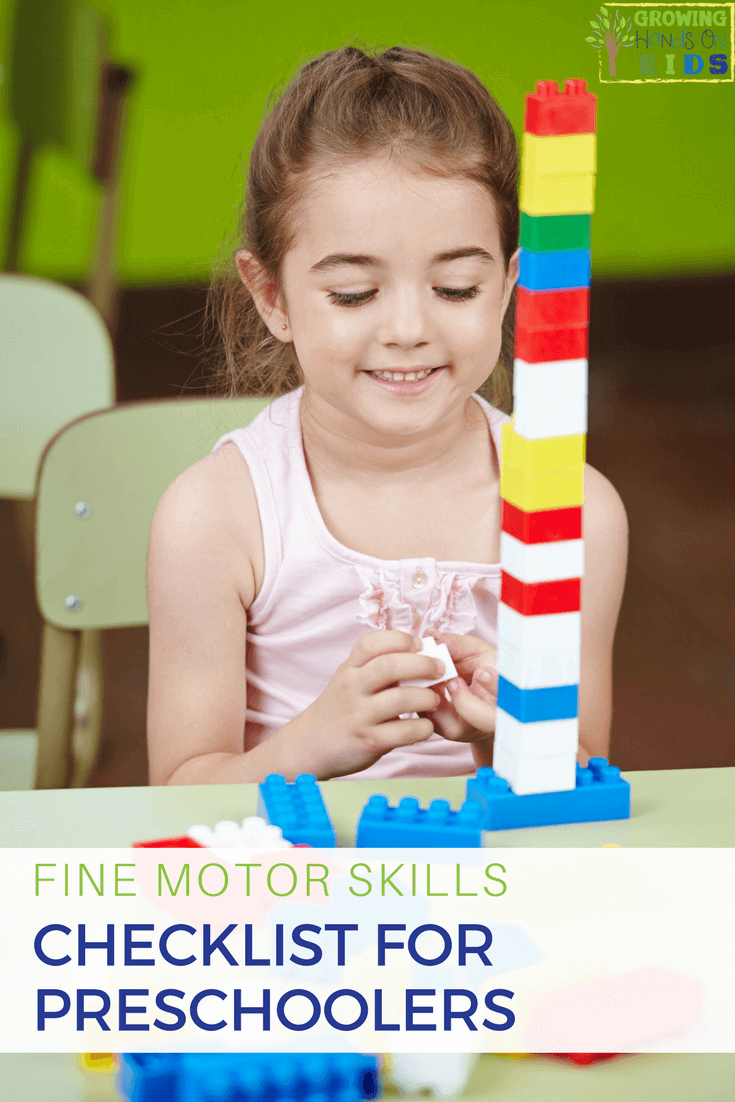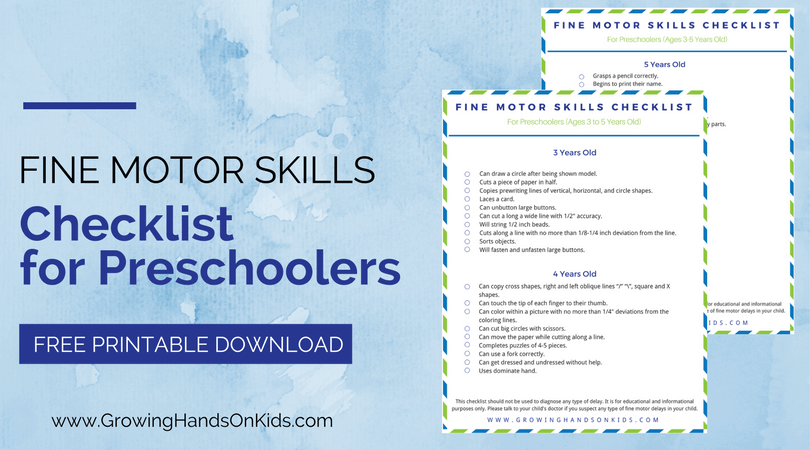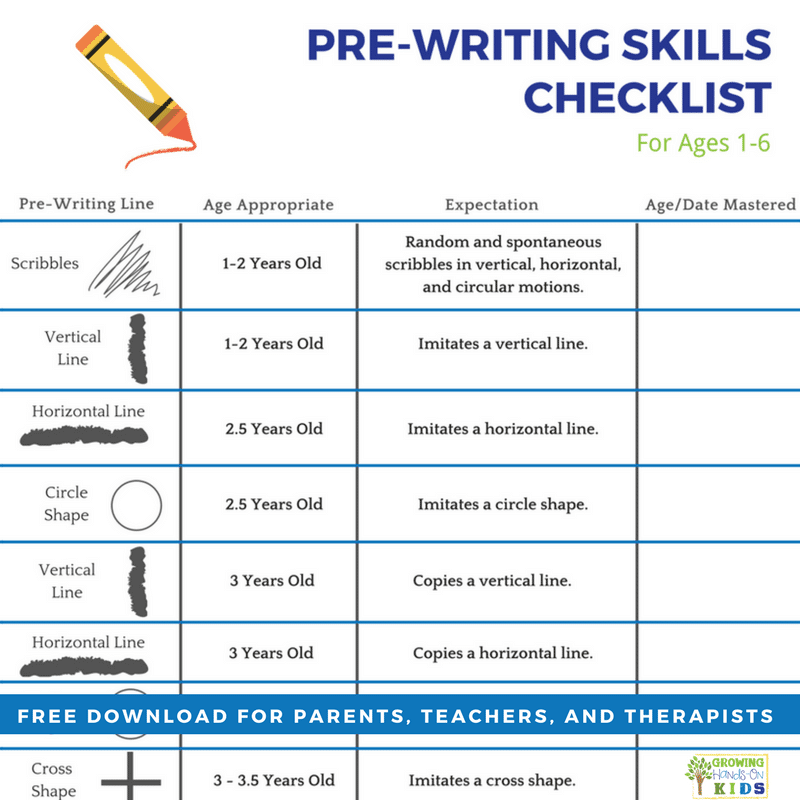Fine Motor Skills Checklist for Preschoolers (Ages 3-5 Years Old)
Affiliate and Referral links are used below to promote products I love and recommend. I receive a commission on any purchases made through these links. Please see my disclosure policy for more details. As an Amazon Associate, I earn from qualifying purchases.
Have you ever wondered what fine motor skills your preschool-age child should be working on? Fine motor activities at this age are important for building future academic success in the school environment. Today I am sharing a fine motor skills checklist for preschoolers, specifically ages 3-5 years old.
Fine Motor Skills Checklist for Preschoolers Ages 3-5 Years Old
A child’s fine motor skills allow him to use small muscles, such as the fingers and hands, in such tasks as writing, drawing, manipulating coins and small toys, and buttoning beads on a string.
I've divided these developmental milestones into ages 3, 4, and 5. At the end of the post, you can get a free one-page download of this checklist to have in your home, classroom, or therapy practice.
Fine Motor Skills for 3-Year-Olds
- Draws a circle after being shown a model
- Cuts a piece of paper in half
- Copies pre-writing straight lines of vertical and horizontal, and circle shapes
- Laces a lacing card
- Unbuttons large buttons
- Cuts a long, wide line with 1/2″ accuracy.
- Strings 1/2 inch beads
Fine Motor Skills for 4-Year-Olds
- Copies a cross shapes, right and left oblique lines “/” “\”, square, and X shapes
- Touches the tip of each finger to their thumb
- Colors within a picture with no more than 1/4″ deviations from the coloring lines
- Cuts big circles with scissors
- Moves the paper while cutting along a line
- Completes puzzles of 4-5 pieces
- Uses a fork correctly
- Gets dressed and undressed without help
Fine Motor Skills for 5-Year-Olds
- Grasps a pencil correctly (see pencil grasp development here)
- Begins to print their name
- Copies a triangle-shape
- Cuts out a circle
- Opens a lock with a key
- Draw a diamond shape when given a model
- Draws a person with at least 6 different body parts
- Ties their shoes
Activity Ideas for Fine Motor Development
Block Towers
Using blocks to build a tower or other designs helps build hand-eye coordination, visual perceptual skills, and more! You can get more ideas on block tower designs here.
Encourage crawling and gross motor skills
Crawling and other gross motor skills help build strong shoulder and core muscles that help support your child's development in the small muscles of the arm and hand.
Using Tongs
Tongs can easily be added to a sensory bin or other fine motor activities to help encourage pincer grasp and improve strength in the small muscles of the hand.
Scooping Activities
This can be done by doing cooking or baking activities, including scoops in a sensory bin, etc. You can use measuring spoons, ladles, or measuring cups and small bowls.
Play Dough
Play dough can be used to make pictures, pre-writing lines and shapes, letters of the alphabet, and more. It is a great way to help improve the small muscles of the hand and wrist.
Zip and Unzip
Learning how to zip and unzip is an important skill for everyday life skills of dressing.
Twisting and untwisting lids
This is another important everyday life skill, especially if your child attends preschool and will go on to Kindergarten. Being able to open the lids of containers and snacks makes lunchtime run a little more smoothly.
Pegs
Pegboards are a great way to work on pincer grasp and finger dexterity.
Using a Knife
You may be nervous about teaching your child to use a knife, but you can do this with nylon knives or small paring knives that aren't as sharp. You can read more about introducing knife skills to your child here.
Focus on pre-writing skills for handwriting development
Focusing on sensorimotor activities for handwriting development should be the focus of preschoolers. Sensory activities such as shaving cream and play dough help build an interest in forming pre-writing lines, strokes, and shapes.
You can read more about pre-writing line development here.
Follow this up with some handwriting practice with paper and a small pencil, perfect for smaller hands.
You can get more fine motor activity ideas for preschoolers here.
If you feel your child has a delay in fine motor development, talk to their pediatrician or doctor and ask for an Occupational Therapy evaluation. Early Intervention is so important at this age and Occupational therapy practitioners are experts in fine motor development.
Free Printable – Fine Motor Skills Checklist for Preschoolers
To get your free fine motor skills checklist for preschoolers, just enter your e-mail address in the form below and click the green “click here” button.
You will need to head over to your e-mail inbox and look for a confirmation e-mail (double check your spam or promotions tab in Gmail).
Click the link in that e-mail to confirm and your download still be automatically sent to your computer (double check the downloads folder if you don't see it right away).
If you are a returning subscriber, this does not cause to subscribe you again. You won't receive duplicate emails. It just lets my email provider know which printable to send to your inbox for you to download.
Subscribe to GHOK & Download!
Subscribe to Growing Hands-On Kids for weekly newsletter activity tips and ideas, just like this one. You'll also be the first to know about new printables, products, and recommended resources.
As a free gift, I'll send you the Fine Motor Skills Checklist for Preschoolers!
By downloading this free printable, you are agreeing with my site's terms of use and privacy policy as detailed here.
You May Also Like:

Heather Greutman, COTA
Heather Greutman is a Certified Occupational Therapy Assistant with experience in school-based OT services for preschool through high school. She uses her background to share child development tips, tools, and strategies for parents, educators, and therapists. She is the author of many ebooks including The Basics of Fine Motor Skills, and Basics of Pre-Writing Skills, and co-author of Sensory Processing Explained: A Handbook for Parents and Educators.




I have a preschool n this checklist help to identify children that how much he grow